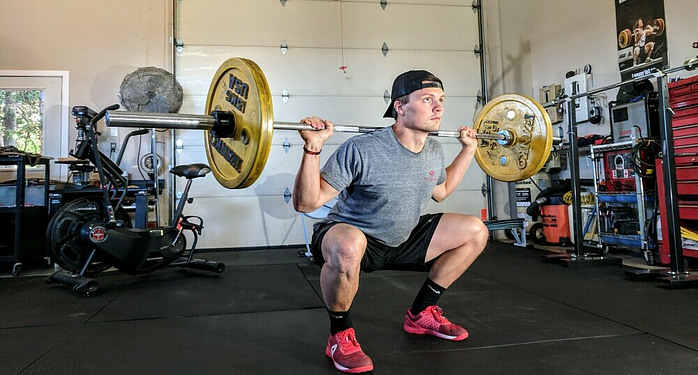Personal health goals often include losing weight and gaining muscle, and I’ve found that effective home workouts can make these goals more achievable than many initially think. You might wonder if it’s truly possible to see such transformations without a gym membership. I assure you, it is. All you need is a clear understanding of how to balance these goals and the commitment to follow through.
Let’s begin by exploring the synergy between two key fitness components that should feature in your home routine: weight training and light cardio. By designing a home workout that includes both, you can burn fat and build muscle concurrently, which is a smart way to maximize your time and efforts.
The beauty of home workouts lies in their convenience and the fact that they can be just as effective as gym workouts. With the right approach, a few pieces of equipment, and sufficient self-discipline, you can create a powerful workout routine that fits into your daily life and moves you steadily toward your desired fitness outcomes. Plus, the comfort of working out in your own space often leads to greater consistency and, ultimately, better results.
But before you grab your weights or lace up your running shoes, it is crucial to understand the underlying principles of what makes a home workout for weight loss and muscle gain truly work. My goal is to guide you through these principles and set you up with a practical strategy that you can start implementing today. I’ll provide you with actionable advice, key exercises, and tips for staying on track—even when life gets busy.
Having established that balance between weight loss and muscle gain is essential, the next step is constructing a weight training plan tailored for your home environment. I’ll walk you through the how-to’s of setting up a home gym space, choosing equipment that won’t break the bank, and selecting exercises that target multiple muscle groups efficiently, to set the foundation for a muscular, lean physique. So, let’s prepare to engage with those weights as we move into crafting your personalized home weight training strategy.
Designing Your Home Weight Training Strategy
When it comes to weight training at home, the key is to develop a strategy that fits your space, budget, and goals. A common misconception is that effective weight training requires a full gym setup. I’m here to assure you that it is entirely possible to build muscle with minimal equipment.
Start by identifying the essential equipment. For most people, adjustable dumbbells, resistance bands, and a sturdy bench or chair are a solid foundation. Weights provide resistance that challenges your muscles, leading to growth over time. Resistance bands offer versatility and can enhance or replace weights in many exercises.
Next, I’ll walk you through several weight training exercises to get you started. These will target the major muscle groups and can be adapted regardless of your fitness level. For example, exercises like squats, deadlifts, push-ups, and shoulder presses are staples that can be performed with dumbbells or improvised weight substitutes.
Finally, it’s critical to understand the principles of progression. As your strength increases, it’s important to increase the weight or resistance to continue challenging your body. This can mean investing in heavier weights, adding more repetitions, or incorporating more advanced variations of exercises.
Remember to maintain proper form at all times to maximize benefits and minimize the risk of injury. Mixing these elements the right way can lead to impressive muscle gains right from your living room.
Integrating Light Cardio for Enhanced Weight Loss
You’ve got your weights in a row and you’re feeling the burn with each lift and press. But remember, to maximize weight loss, you need to rev up your heart rate too. Light cardio is the perfect complement to your weight training efforts, helping you torch more calories while improving cardiovascular health. Don’t worry; this doesn’t mean you have to spend hours on a treadmill. Let’s explore options that suit the home environment.
Light cardio is all about maintaining a moderate intensity. It accelerates your heart rate to a fat-burning pace without pushing you to the brink. Think brisk walking, low-impact aerobics, or even cycling at a steady rate. It’s the kind of workout that leaves you slightly out of breath, yet able to converse.
Here are some go-to light cardio examples that are perfect for home workouts:
– Skipping rope: It’s not just for kids. Ten minutes can burn as many calories as a 30-minute jog.
– High knees: March in place with purpose for a surprisingly effective cardio session.
– Stair climbing: If you have stairs at home, you have a cardio powerhouse at your disposal.
– Dance workouts: Find an online video and groove your way to better health.
When integrating light cardio with weight training, it’s all about timing and balance. Alternate your days between lifting and cardio, or if you prefer, dedicate the first half of your workout to weights and the second to cardio. This sequencing ensures you have enough energy for strength training before moving on to calorie-blasting movements.
As you pencil in your light cardio sessions, keep an eye on the intensity. A simple way to monitor this is through the ‘talk test’; you should be able to maintain conversation, but not comfortably sing a tune. Staying in this zone helps you stay in the fat-burning state without overtaxing your body or risking burnout.
Creating a Weekly Workout Schedule for Success
I understand the eagerness to jump right in and see results immediately. After all, that’s what motivates us to start. Yet, the key to losing weight and gaining muscle sustainably is to develop a balanced routine that you can stick to long term.
Creating a weekly workout schedule isn’t just about penciling in workouts; it’s about understanding your body’s need for rest and recovery as much as it needs activity. A well-structured plan allows muscles to heal and grow while ensuring that you’re burning calories consistently.
When designing your weekly plan, alternate between weight training and light cardio sessions. Here’s an example of what a week might look like: Monday, Wednesday, and Friday could be weight training days, focusing on different muscle groups each day. Tuesdays and Thursdays can be reserved for light cardio, like brisk walking or cycling, to keep your heart rate up without overtaxing your body.
Remember, rest days are crucial. They’re not a sign of laziness, but an important aspect of your fitness regimen. Saturdays could be your day off to relax, and Sundays might include a light activity such as yoga or a leisurely walk, which aids in active recovery.
Keep track of your workouts and your progress. Noting down the exercises performed, weights used, and reps completed can help identify improvements and areas for adjustment. Monitoring your body’s responses will allow you to tweak your schedule for better results.
Staying motivated is often a challenge. Having a weekly plan helps, but do look for other motivators that work for you, such as workout playlists, joining online fitness communities, or setting up reward systems for milestones achieved.
As you follow this weekly routine, you’ll build the foundation for a fitter, stronger self. And when it comes to locking in these gains, don’t forget the critical role that diet and lifestyle play, which is what we will explore next in our journey towards a healthier you.
Nutrition and Lifestyle: The Crucial Pillars Supporting Your Fitness Goals
I understand that transforming your body is more than just a series of workouts. A well-rounded approach is what drives sustainable change. Here, I’ll discuss why diet and lifestyle choices are not mere footnotes in your fitness story, but essential chapters that merit your attention.
Nutrition is not just about eating less but eating right. To lose weight and gain muscle, the body requires quality fuel. I’ll highlight the staples of a diet that works in tandem with your exercise plan. This includes balanced macronutrients, sufficient protein intake, and why hydration can’t be overlooked. Remember, CONSISTENCY in your diet complements the hard work you put in during workouts.
Sleep and stress have a profound impact on your fitness. A lack of sleep can sabotage weight loss and muscle recovery, while unchecked stress may lead to overeating and skipped workouts. It’s not just about the hours you spend exercising; the hours you spend recovering are just as crucial.
Embrace lifestyle modifications that bolster your fitness efforts. Small, daily habits like taking the stairs, weekly meal planning, and mindfulness practices make a significant cumulative difference over time. These seemingly minor tweaks can accelerate your progress and help maintain the gains you’ve worked so hard for.
In conclusion, giving weight training and light cardio their due importance is vital, but don’t overlook the power of nutrition and lifestyle. They’re the foundation that allows your fitness structure to stand tall and withstand the test of time. As you keep pushing forward, remember that HEALTHY HABITS go hand in hand with exercise to sculpt the fit, strong body you aspire to.